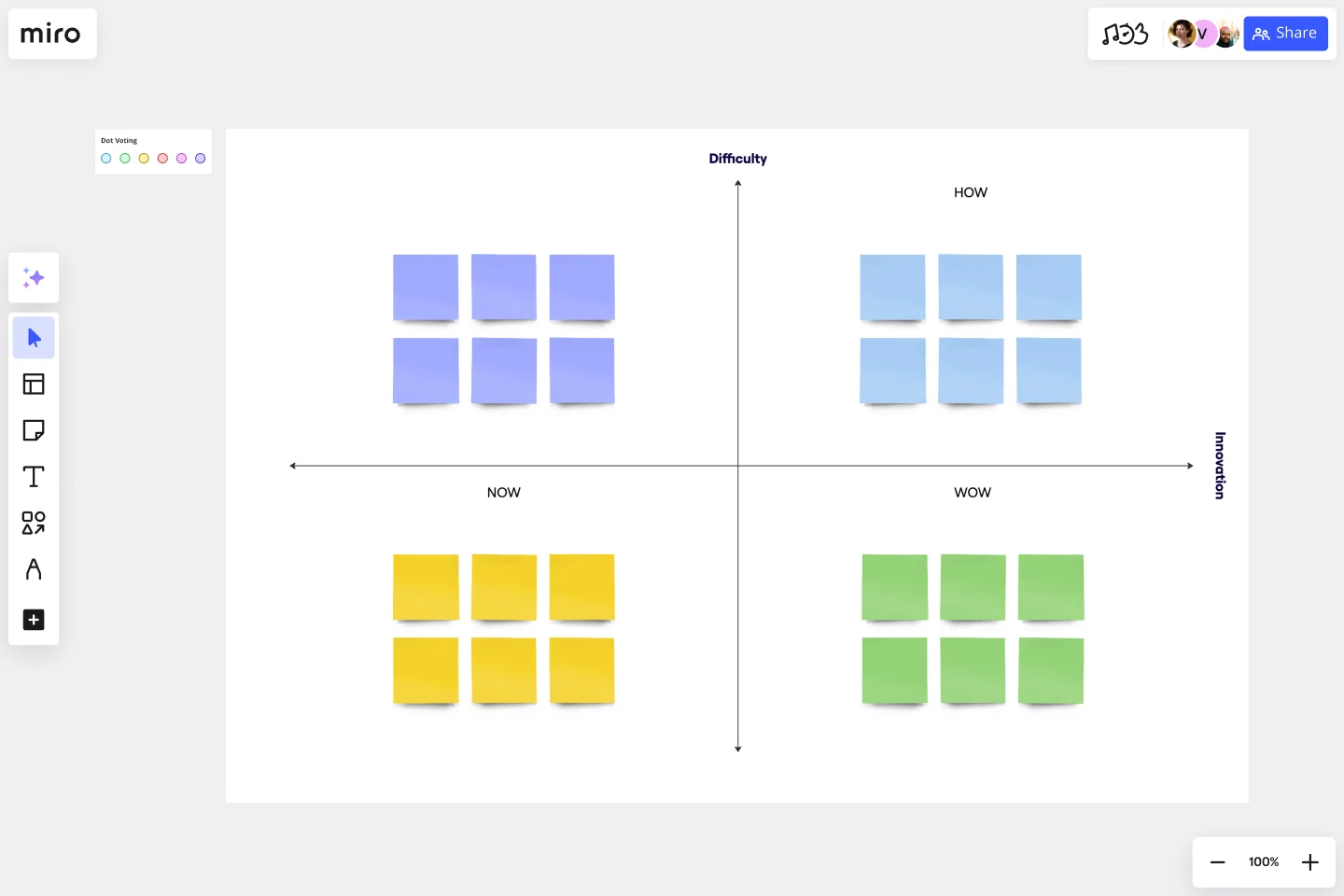How Now Wow Matrix Template
Brainstorm and organize ideas based on their originality and ease of implementation.
About the How Now Wow matrix template
What is How Now Wow?
Brainstorming is difficult — but it becomes increasingly difficult as you scale. As you release more and more innovative products and services, it’s harder for your team to get creative. Complicated workflows, hard judgment calls, and resource constraints often force you to be conservative when you’d rather take risks. To overcome this challenge and reinvigorate your team, you can use the How Now Wow matrix.
The How Now Wow matrix is a game that fosters creativity. It consists of a 2x2 matrix with “originality” on the X-axis and “feasibility” on the Y-axis. You work with your team to file your ideas into each category. Working through the matrix can empower you to overcome creative roadblocks.
How do you use the How Now Wow matrix?
The horizontal axis represents originality and rates ideas as normal or innovative. The vertical axis represents ease of implementation and rates ideas as easy or difficult to implement. Ideas that are unoriginal and challenging probably aren’t worth pursuing. “How” ideas that are innovative but difficult to execute may need further work before you can act upon them. “Now” ideas are generally considered low-hanging fruit. “Wow” ideas are both innovative and relatively easy to implement, so this is where you’ll want to try to focus your attention.
The 3 Aspects of How Now Wow
How: Difficult to implement.
This category consists of ideas that are innovative but infeasible. It’s a helpful way to set ambitious goals for the future.
Now: Easy to implement.
These ideas are familiar, so you know they work well.
Wow: Original and easy to implement.
This category describes creative ideas that are relatively simple to execute. Try to file as many ideas into this category as possible.
Who can use the How Now Wow matrix?
The How Now Wow matrix is versatile enough to be used by any number of teams. Use it whenever you’d like to encourage your team to do creative brainstorming. In order to encourage maximum creativity, you may find it beneficial to break teams into smaller groups or let people brainstorm individually before sharing their ideas with a larger group.
Get started with this template right now.
Six Thinking Hats Template
Works best for:
Ideation, Brainstorming
The Six Thinking Hats by Dr. Edward de Bono was created as an alternative to argument, it is designed to help teams explore and develop ideas collaboratively. Use this template to boost creative thinking and get different perspectives so you and your team can make better-informed decisions.
Disney Creative Strategy Template
Works best for:
Business Management, Ideation, Brainstorming
Know who knew a little something about coming up with ideas that set imaginations alight? Walt Disney. And he inspired the Disney Creative Strategy, an approach that establishes three types of thinkers—dreamers, realists, and critics—and gives each the space to do clear thinking. Your team will go through an engaging exercise of adopting the three mindsets, where they’ll focus on a specific aspect of the idea. The Disney Creative Strategy has a way of yielding brilliant ideas and great products. That’s why it’s used successfully by organizations of all kinds and sizes.
Workflow Template
Works best for:
Project Management, Workflows
The digital world requires collaboration, and better collaboration leads to better results. A workflow is a project management tool that allows you to sketch out the various steps, resources, timeline and roles necessary to complete a project. It can be used on any multi-step project, whether it’s a business process or otherwise, and is ideal for plotting out the tangible actions you’ll need to take to achieve a goal and the order in which you need to complete those actions.
BCG Matrix Template
Works best for:
Strategic Planning
Use the BCG matrix template to make informed and strategic decisions about growth opportunities for your business. Assign your portfolio of products to different areas within the matrix (cash cows, dogs, question marks, stars) to prioritize where you should invest your time and money to see the best results.
SAFe Program Board
Works best for:
Agile Methodology, Diagrams, Agile Workflows
Many organizations use the Agile model, but even companies that don’t rigorously adhere to all Agile standards have adopted Agile tools and methods like Program Increment (PI) Planning. Even if you’re not participating in a formal PI session, a program board can be a great way to establish communication across teams and stakeholders, align development objectives with business goals, clarify dependencies, and foster cross-functional collaboration. The board provides much-needed structure to planning sessions, yet is adaptable enough to accommodate brainstorming and alignment meetings.
3-Circle Venn Diagram
Works best for:
Education, Diagrams, Brainstorming
Venn diagrams have been a staple of business meetings and presentations since the 1800s, and there’s a good reason why. Venn diagrams provide a clear, effective way to visually showcase relationships between datasets. They serve as a helpful visual aid in brainstorming sessions, meetings, and presentations. You start by drawing a circle containing one concept, and then draw an overlapping circle containing another concept. In the space where the circles overlap, you can make note of the concepts’ similarities. In the space where they do not, you can make note of their differences.
